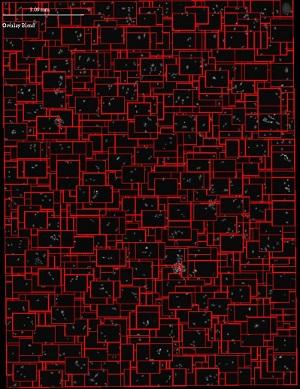Performance of Scalable Systems
Performance of Scalable Systems:
Image Stitching for Microscopy
Overview

Most high-end microscopy systems include an image-stitching tool.However, these tools are often manufacturer-specific and require fully calibrated equipment, a condition that is not always satisfied.An alternative is to use a provider-neutral tool for image stitching (e.g., the open source ImageJ/Fiji tool).Unfortunately, these tools are not focused on delivering the performance needed to enable time-based experiments (ImageJ took several hours to stitch the image grid shown to the right on a high-end workstation).Furthermore, these tools do not provide the accuracy guarantees needed to enable imaging-based bioscience-oriented measurements.
Industry Need Addressed
Computational tools that enable the stitching and processing of very large images can play a pivotal role in the development of imaging-based bioscience-oriented measurements.Such tools will allow scientists to use quantitative measurements that can play a critical role in the development of novel therapies (e.g., using stem cell) and ensuring their safety.
NIST Approach
NIST has developed a high performance stitching tool, MIST v1.0 (Microscopy Image Stitching Tool), and released it on GitHub (https://github.com/NIST-ISG/MIST).The tool is available as a plugin to ImageJ to increase its reach.
MIST has a multithreaded implementation to utilize all CPU cores and carefully manages memory to increase execution speeds by up to two orders of magnitude over the leading alternative tool.MIST also takes advantage of available GPUs to accelerate the computation by another 5–10x.We will investigate the use of Cloud Computing technologies and other infrastructural technologies to mitigate the issues uncovered during an initial investigation of the behavior of bioinformatics tools on large datasets. The results of an initial parameter sensitivity evaluation was used to design an experiment for a more formal parameter sensitivity study and algorithm analysis to determine causes for observed algorithm behavior.
Impact
MIST v1.0 is currently used as a standalone tool by NIST bio-scientists.It is already integrated into a web-oriented image processing workflow that is also being used at NIST and is being considered by colleagues at other agencies.It provides a solid foundation for handling time-series studies and for developing quantitative measurements based on very large microscopy images.

